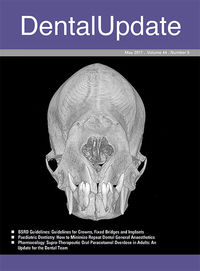Practical considerations for treatment of patients taking bisphosphonate medications: an update
Abstract
Osteonecrosis of the jaw–bisphosphonate-related (ONJ-BR) is an established clinical entity associated with both oral and intravenous (IV) bisphosphonate therapy. An update for the general practitioner on the indications for bisphosphonate therapy and both risk assessment and prevalence of ONJ-BR is provided. Management philosophy within a local unit is illustrated through four brief case studies. It is not uncommon to encounter patients on bisphosphonate therapy in the dental practice environment; the vast majority of these will be on oral bisphosphonates as part of their management for osteoporosis. The risk of developing ONJ-BR is rare in these patients compared with those receiving treatment for skeletal complications associated with cancer, many of whom will be managed with IV bisphosphonates. Although rare, it is important to recognize the potential risk of ONJ-BR. Whilst most patients on oral bisphosphonates can be managed no differently from other patients, it should be appreciated that the relative risk of long-term cumulative exposure, comorbidity and other factors are still to be determined. Surgical intervention and extractions can place the patient at risk of ONJ-BR and vigilance is necessary to ensure that healing progresses satisfactorily. Early referral to the local hospital should be sought if there is cause for concern.
CLINICAL RELEVANCE:
Although the risk of ONJ-BR is low in non-oncological indications, it is important to be aware that it exists and to know how the risk may be minimized.

